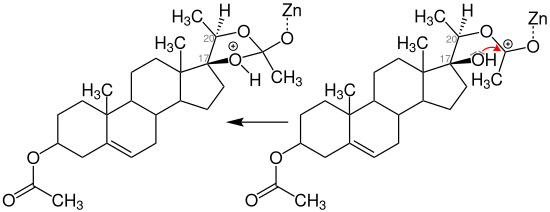Serini reaction
The Serini reaction is a name reaction in organic chemistry . This was discovered by Karl Heinrich Slotta and Klaus Neisser and used for the first time by Arthur Serini (1897–1945) in the research of steroids .
Overview reaction
With the help of the Serini reaction, steroidal 17-hydroxy-20-acetic acid esters can be converted into ketones with an unchanged steroid backbone, which also experience a reversal of configuration at carbon atom 17 of the steroid .
General
Toluene is used as the solvent for the Serini reaction . The solution is refluxed over a period of 4-5 hours. The zinc dust is activated beforehand with the help of dilute hydrochloric acid and then washed extensively and then dried. After the reaction, the zinc dust is filtered off and the solution is evaporated.
Reaction mechanism
The reaction mechanism of the Serini reaction has been discussed controversially in many papers. One possible reaction mechanism is zinc as a catalyst, which acts as a Lewis acid. In this case, the oxygen of the carbonyl group of the acetate substituted on carbon atom 20 would attack the zinc dust nucleophilically. The resulting positive charge leads to the formation of a cyclic orthoacetate anion through electron pair shifts.
A carbonyl compound with carbon atom 20 is formed and acetate is split off. Furthermore, there is a 1,2-hydride shift and an inversion of configuration at carbon atom 17.
Another proposed reaction mechanism is based on the assumption that reactive zinc leads to the formation of a zinc alcoholate . In this variant, the first thing that occurs is the deprotonation of the hydroxyl group on carbon atom 17. The alcoholate formed attacks nucleophilically on the carbon atom of the carbonyl group of the acetate. A cyclic ortho- acetate anion is formed as an intermediate. In this variant, too, a carbonyl compound with carbon 20 is formed next. A 1,2-hydride shift occurs with a configuration reversal at carbon atom 17.
An earlier idea that a 17,20-oxide is formed as an intermediate was long accepted, but ultimately refuted.
application
The Serini reaction is used to produce ketones from derivatives of 17-hydroxy-20-acetoxy-sterol. This means that the reaction can be used for the total synthesis of steroids. Furthermore, the Serini reaction can also be transferred to open-chain trisubstituted glycol monoacetates in order to synthesize ketones.
Individual evidence
- ↑ Arthur Serini, Willy Logemann, Walter Hildebrand: About the representation of ingredients of the adrenal cortex. In: Reports of the German Chemical Society. 72, 1939, p. 391, doi : 10.1002 / cber.19390720228 .
- ↑ Karl Heinrich Slotta, Klaus Neisser: To the chemistry of coffee, IV. Communication: To clarify the constitution of the cafesterol . In: Reports of the German Chemical Society . tape 71 , no. 11 , 1938, pp. 2342-2346 , doi : 10.1002 / cber.19380711122 .
- ↑ CW Shoppee: The Serini reaction . In: Experientia . tape 4 , no. 11 , 1948, pp. 418-420 , doi : 10.1007 / BF02144987 .
- ^ A b G. Goto, K. Yoshioka, K. Hiraga: The serini reaction of 16,17-dihydroxysteroid monoacetates . In: Tetrahedron . tape 30 , no. 14 , 1974, p. 2107-2114 , doi : 10.1016 / S0040-4020 (01) 97346-6 .
- ↑ Eugene Ghera: Heterogeneous reactions with zinc. II. General synthesis of ketones from 1,2-trisubstituted glycol monoesters and the mechanism of the serini reaction . In: The Journal of Organic Chemistry . tape 35 , no. 3 , 1970, p. 660-666 , doi : 10.1021 / jo00828a025 .
- ↑ CW Shoppee: 360. Steroids and the Walden inversion. Part V. The Serini reaction . In: Journal of the Chemical Society . 1949, p. 1671-1680 , doi : 10.1039 / JR9490001671 .
- ^ Toshio Goto, Louis F. Fieser: Mechanism of the serini reaction . In: Journal of the American Chemical Society . tape 83 , no. 1 , 1961, pp. 251-252 , doi : 10.1021 / ja01462a054 .
- ↑ Helmut Krauch, Werner Kunz: Name reactions and reagents in organic synthesis . 6th edition. Wiley-VCH, Weinheim 1997, ISBN 978-3-527-29713-9 , pp. 351-353 .



